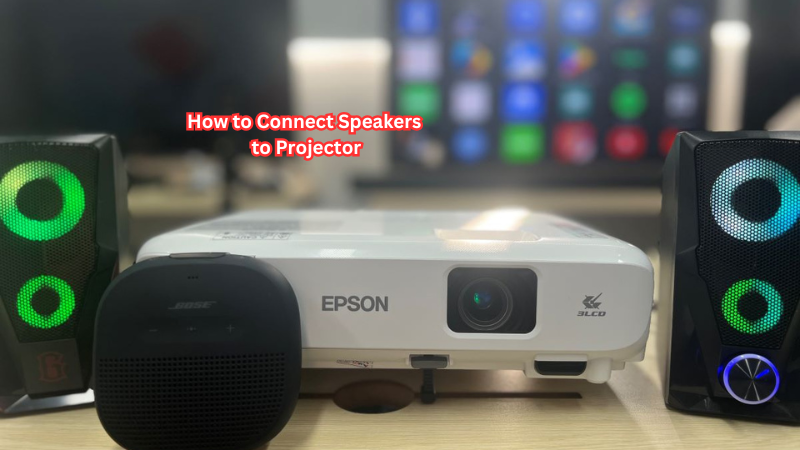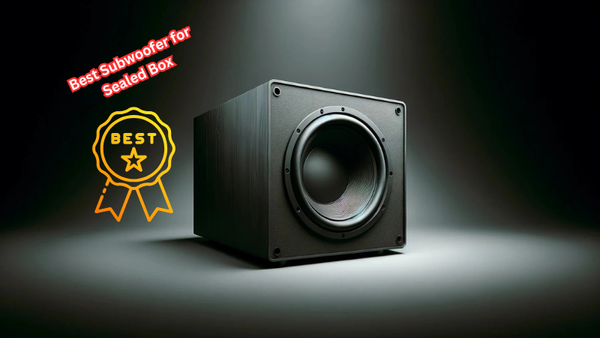Enhancing your audio experience is crucial, whether you're hosting a presentation, enjoying a movie night, or diving into an immersive gaming session.
Built-in projector speakers often fall short of delivering the rich and powerful sound needed for these activities. Connecting external speakers to your projector can transform your setup, offering superior audio quality and elevating the overall experience.
This guide will walk you through the process of connecting speakers to a projector, covering everything from the necessary equipment to step-by-step connection instructions.
You'll also find troubleshooting advice and tips for optimizing sound quality. Dive into this guide to unlock the full potential of your audio setup and enjoy an enriched listening experience.
Understand the Compatibility Between Your Projector and Speakers
Before diving into the connection process, it's important to ensure that your projector and speakers are compatible with each other.
The first step is to check the input/output ports available on both your projector and speakers. Most modern projectors come equipped with HDMI or VGA ports, while external speakers often have auxiliary (AUX) or RCA inputs. Make sure you have the correct cables to connect both devices.
It's also essential to consider the power output of your projector and speakers. If your projector has a built-in amplifier, it may not be powerful enough to support external speakers that require external power sources.
In such cases, an audio receiver or amplifier will be necessary for connecting your speakers to the projector. Be sure to check the power requirements of your speakers before making any connections.
Benefits of Connecting Speakers to a Projector
Before we dive into the technical aspects, it's essential to understand the benefits of connecting speakers to your projector. Here are some key advantages:
- Enhanced audio quality: As mentioned earlier, built-in projector speakers often lack in delivering powerful and high-quality sound. By connecting external speakers, you can greatly enhance the audio experience and enjoy crisp and clear sound.
- Versatility: Projectors allow for a variety of uses, from presentations and movie nights to gaming sessions. By connecting external speakers, you can customize your setup according to your needs and preferences, making it versatile for different activities.
- Better sound distribution: Projectors are designed to project images onto a large screen, making them ideal for group viewing or presentations. By connecting speakers, you can ensure that the audio is evenly distributed across the room, allowing everyone to hear clearly.
- Multiple speaker options: With built-in projector speakers, you're limited to one type of sound. However, by connecting external speakers, you have a wide range of options to choose from, such as surround sound systems or portable Bluetooth speakers.
Step-by-Step Guide: How to Connect Speakers to Projectors
Now that you understand the compatibility and benefits of connecting speakers to a projector, let's dive into the step-by-step guide for making the connection. Follow these instructions to set up your audio system and elevate your viewing experience:
Necessary Equipment
Before starting the connection process, make sure you have the following equipment:
- Projector with available input/output ports (HDMI or VGA)
- External speakers with compatible inputs (AUX or RCA)
- Correct cables to connect both devices (HDMI, VGA, AUX, or RCA)
- Audio receiver or amplifier if needed
Step 1: Prepare Your Workspace
Start by setting up your projector and speakers in their desired locations. It's essential to ensure that both devices are within reach of each other and have a clear line of sight for the best audio performance.
Step 2: Connect the Speakers to the Audio Receiver/Amplifier
If your speakers require external power sources, connect them to the audio receiver or amplifier using the appropriate cables. This step may be skipped if your speakers have built-in amplifiers and can be powered through USB or batteries.
Step 3: Connect the Projector to the Audio Receiver/Amplifier
Using an HDMI or VGA cable, connect your projector's output port to the corresponding input port on your audio receiver or amplifier. If your projector only has one output port, use a splitter to connect both the audio receiver/amplifier and display device.
Step 4: Check the Audio Settings on the Projector
Power on your projector and navigate through its settings menu to ensure that the audio output is set to external speakers. It's important to disable the internal speakers of the projector to avoid any interference.
Step 5: Test the Connection
With everything connected and set up, it's time to test the audio connection. Play a familiar audio source and adjust the volume accordingly. If you encounter any issues, refer to the troubleshooting section below.
Connecting Wireless Speakers
Wireless speakers have become increasingly popular in recent years due to their convenience and versatility. If you own wireless speakers, you can still connect them to your projector using a wireless audio transmitter. These devices allow for a seamless connection between your projector and wireless speakers without any cables.
To make this connection, follow these steps:
- Connect the wireless audio transmitter to the audio output of your projector (usually through an AUX or RCA port).
- Power on both the projector and the wireless speakers.
- Pair the transmitter with the speakers according to the manufacturer's instructions.
- Test the connection by playing an audio source.
If you encounter any issues, refer to the troubleshooting section below.
Troubleshooting Common Issues
Here are some common issues you may encounter and their possible solutions:
No sound:
Ensure all devices are properly connected, and the correct audio output is selected on the projector. Check the volume levels on both the projector and speakers.
Audio out of sync:
This could be due to a delay in wireless connections or a mismatch between audio and video settings. Try adjusting the audio and video settings on your projector.
Poor sound quality:
Make sure all connections are secure and that there is no interference from other electronic devices. Adjust equalizer settings on the audio receiver/amplifier for optimal sound performance.
These are some basic troubleshooting tips, but if you continue to experience issues, refer to the user manuals of your devices or seek professional assistance.
Additional Tips for Optimizing Sound Quality
Aside from connecting external speakers, here are some additional tips to optimize the sound quality of your projector setup:
- Room acoustics: The acoustics of a room can greatly impact the sound quality. Consider adding acoustic panels or furniture to absorb sound and reduce echo.
- Speaker placement: Experiment with speaker placement to find the optimal position for ideal sound distribution. Avoid placing them too close to walls or corners as this can cause bass distortion.
- Cable length and quality: Use high-quality cables and avoid using excessively long ones, as they can result in signal loss and affect audio quality.
- Audio settings on projector: Most projectors come with basic audio settings that you can adjust to enhance sound quality. Experiment with these settings to find the best configuration.
- External audio equipment: If you're looking for a more advanced audio setup, consider investing in external audio equipment such as a surround sound system or subwoofer to further enhance your viewing experience.
So, there you have it - a comprehensive guide on how to connect speakers to a projector. By following these steps and tips, you can elevate your movie nights, presentations, or gaming sessions to the next level with superior audio quality.
Does Calibration Matter?
Calibrating your audio equipment can make a significant difference in the overall sound quality.
This process involves adjusting various settings on your projector and speakers to ensure they work together harmoniously. You can either manually calibrate or use specialized calibration tools, but it's recommended to seek professional assistance for optimal results.
Also, keep in mind that the type of content you are projecting may require different audio settings. For example, a movie may benefit from different audio settings than a presentation or video game. Experiment with different calibrations to find what works best for your specific needs.
FAQs
What type of speakers do you need for a projector?
This will depend on your specific projector and audio receiver/amplifier setup, but generally, you can use any type of speaker with a compatible audio input. Popular options include bookshelf speakers, soundbars, and wireless speakers.
Can I connect Bluetooth speakers to a projector?
Yes, as long as your projector has the capability to connect to Bluetooth devices or if you use a wireless audio transmitter.
Do I need an amplifier for my speakers?
If your speakers have built-in amplifiers, then no external amplifier is needed. However, if your speakers require external power sources, you will need an amplifier or audio receiver to power them.
Conclusion
As you wrap up your journey to connect speakers to your projector, remember the remarkable difference enhanced audio can make in presentations, movie nights, and gaming sessions. By following this guide, you've equipped yourself with the knowledge to set up a superior sound system, transforming your media experiences.
Don't hesitate to experiment with various configurations and settings to discover the perfect sound quality that suits your environment.
With your new setup, you’re poised to enjoy an enriched audio experience that brings your visuals to life. Embrace the power of excellent sound, and let your enhanced setup elevate every moment to new heights of enjoyment.





